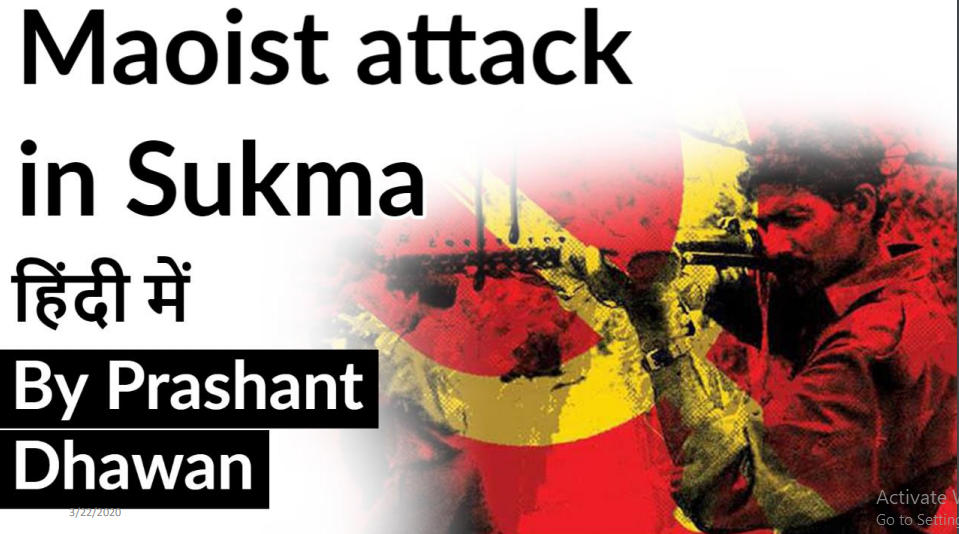Table of Contents
THE DETAILS
- A joint team of District Reserve Guard (DRG), Special Task Force (STF) and Commando Battalion for Resolute Action (CoBRA)- an elite unit of CRPF
- 12 jawans belonged to DRG while 5 were from STF
DETAILS
- This is the biggest death toll among the forces in Chhattisgarh in three years.

SUKMA DISTRICT
- Sukma district is the newly formed, southernmost district in the Indian state of Chhattisgarh.
RED CORRIDOR
- In 2018 Ministry of Home Affairs (MoHA) has redrawn the red corridor region which are affected by Left-wing extremism.
- Red corridor region is demarcated by the union government to notify the districts which are affected by left wing extremism.
- It is spanning across 106 districts in 10 States, namely Bihar, Jharkhand, Andhra Pradesh, Maharashtra, Odisha, Telangana, West Bengal, Madhya Pradesh, Uttar Pradesh and Chhattisgarh.

IMPACT
- A recent report of MoHA classifies the red corridor region with respect to the severity of the Naxal influence. The three main categories are – Severely affected – Chhattisgarh, Jharkhand, Odisha and Bihar Partially affected -West Bengal, Maharashtra and Andhra Pradesh Slightly affected – Uttar Pradesh and Madhya Pradesh
AFFECTED DISTRICTS
- THE 30 MOST AFFECTED LWE DISTRICTS NOW
- Andhra Pradesh: Vishakhapatnam Bihar: Aurangabad, Gaya, Jamui, Lakhisarai Chhattisgarh: Bastar, Bijapur, Dantewada, Kanker, Kondagaon, Narayanpur, Rajnandgaon, Sukma Jharkhand: Bokaro, Chatra, Garhwa, Giridih, Gumla, Hazaribagh, Khunti, Latehar, Lohardaga, Palamu, Ranchi,SimdegaWest, Singhbhum
NAXALISM IN INDIA
- The term Naxalism derives its name from the village Naxalbari of West Bengal. It originated as rebellion against local landlords who bashed a peasant over a land dispute. The rebellion was initiated in 1967, with an objective of rightful redistribution of the land to working peasants under the leadership of Kanu Sanyal and Jagan Santhal.
CAUSES
- Tribal discontent: The Forest (Conservation) Act, 1980 deprives tribals, who depend on forest produce for their living, from even cutting a bark. Massive displacement of tribal population in the naxalism-affected states due to development projects, mining operations and other reasons. Easy Target for Maoists: Such people who do not have any source of living are taken into naxalism by Maoists. Maoists provide arms and ammunitions and money to such people.
STEPS TAKEN BY THE GOVERNMENT
- Operation Green Hunt: It was started in 2010 and massive deployment of security forces was done in the naxal-affected areas. From 223 districts that were affected due to naxalism in the year 2010, the number has come down to 90 in nine years.
STEPS TAKEN BY THE GOVERNMENT
- The government even started ‘Relief and Rehabilitation Policy’ for bringing naxalites into mainstream. Aspirational Districts Programme: Launched in 2018, it aims to rapidly transform the districts that have shown relatively lesser progress in key social areas.
WHAT MORE CAN BE DONE
- Government needs to arm the security forces in Naxal Affected areas with better equipment so they can face Naxalites in thick forests Local Police knows the language and topography of a region; it can fight naxalism better than the armed forces. Andhra Police rose ‘Greyhounds’; special forces to deal with naxalism in the state.























 WhatsApp
WhatsApp